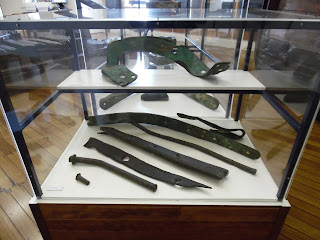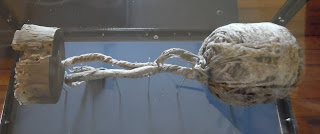It has been an extremely busy and productive past couple of
weeks at the museum as we have benefited from the valuable skills and time
offered by two wonderful volunteers. Sue
and Don Brian are not strangers to Norfolk; they left the island eighteen
months ago after living here for five years.
Don taught science and chemistry at NICS and Sue volunteered her time to
the museum four days a week for the most of that time, Sue had to have
Wednesdays off from the museum so she could attend to weaving with the guys at
the Golden Orb, and if she wasn’t at either of those places, you could find her
volunteering for the National Park.
Outside of these times they were involved in many other charitable
activities supporting the island.
What they have achieved for the museum these past two weeks
is just remarkable.
Sue developed a
template that enables us to upload multiple entries into our database in one
single upload. This is no mean feat
considering there are more than eighty fields and multiple layers of
classifications necessary for the cataloguing.
This template has enabled us to finally upload the Les Brown Collection
of over 1,000 files, plus books and images into our database. This week Sue has uploaded more than 2,000
entries into our database. Sue’s
previous volunteer work with the museum was mainly in the field of conservation,
with a science background, she was perfect for the job, this week she has been
able to provide instruction in conservation techniques to Gaye Evans, who has
recently joined us at the museum.
Don originally planned for a one week holiday and extended to
two. He was kept busy for the first week
digitising our entire collection of cassette tape recordings. This digitising work is done in ‘real time’,
outsourcing for this project would have cost hundreds. Amongst this collection of cassette tapes is
a recent donation by Chris Nobbs including nineteen oral history interviews he
conducted during the 1980s and ‘90s, now we can hear those voices and listen to
those stories.
The final day of their ‘holiday’ on Norfolk was taken up
with performing the next step in the conservation of the artefacts recently
recovered from the works in the Blacksmith’s Compound. More than one hundred ferrous objects were
brushed and then placed back into fresh solutions of 2% sodium hydroxide; this
part of the conservation process is to remove the corrosion causing chloride
from the objects. Sue’s work on the
cataloguing template will be greatly appreciated again when it comes time to
record these items into our database.
These are the major projects accomplished during their two
weeks on island, there were many other tasks completed along the way. Sue and Don, your generosity and achievements
are immeasurable, a huge thank-you to you both from a truly grateful Norfolk
Island Museum. Come back soon ..okay!







